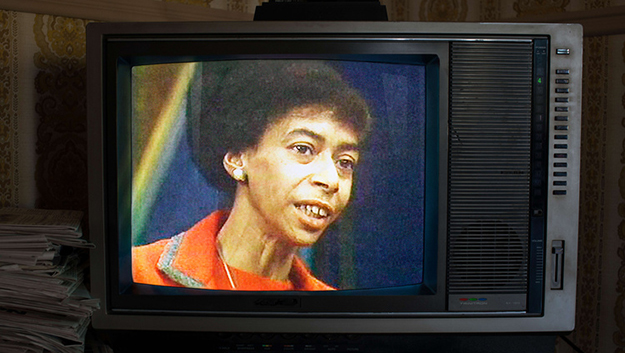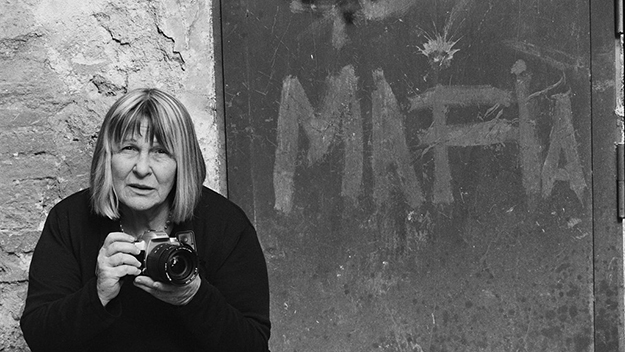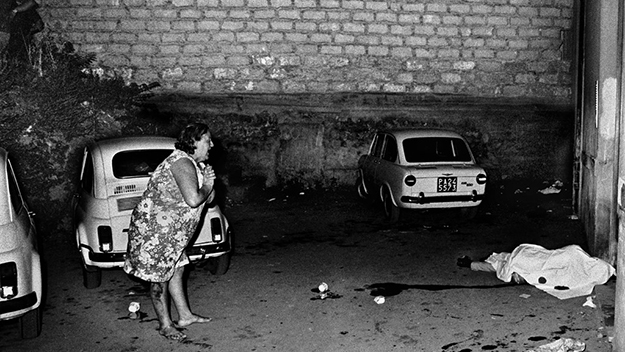Recorder: The Marion Stokes Project, Shooting the Mafia, and The Irishman

Recorder: The Marion Stokes Project (Matt Wolf, 2019)
As a technology, videotape was both deeply flawed and radical in its impact. Magnetic media, VHS in particular, degrades quickly, and in an especially unattractive way: there is no elegant patina to the image quality of old videotapes: the picture gets fuzzy and melted, like an old cough drop you find at the bottom of your bag. It gets wobbly and jumpy and eventually shreds into static. But the advent of the VCR made it possible for everyone to copy and own moving images far more easily and inexpensively than ever before. Filmmaker Matt Wolf summons affection for this obsolete format—fetishizing the black plastic cassettes and reveling in the ugly-Christmas-sweater look of old video footage—in Recorder: The Marion Stokes Project (2019), his portrait of a woman who between 1979 and her death in 2012 obsessively taped TV news twenty-four hours a day, amassing a “secret archive” of 70,000 tapes.
Her project began with the Iranian hostage crisis; she died the day of the Sandy Hook elementary school shooting, and only when she stopped breathing did her staff turn off the multiple VCR’s running in her apartment. Alert to and concerned by how the media shapes news stories and manipulates audiences, she made her compulsive recording a form of activism, though the project was “ideologically agnostic,” in Wolf’s words, aiming to preserve the ceaseless, wall-to-wall saturation of television, not to curate it. She was a hoarder of many things, from newspapers to Apple computers, but mainly a hoarder of images. After her death, her heirs had trouble finding an institution to take her collection, but it was finally acquired by the Internet Archive in San Francisco which, given its mission to preserve the contents of the world wide web, is undaunted by terrifying overabundance.
Recorder’s real focus is the enigma of the person behind this insanely quixotic project. Marion Stokes, an African-American woman who suffered abandonment as a child, grew up to be a librarian, political radical (at one point moving to Cuba with the intention of defecting), and outspoken commentator on the TV debate show Input. She married twice, and retreated into seclusion with her second husband in an old-money Philadelphia apartment building where she pursued her life’s work, recording TV news on as many as eight stations at once. Wolf mines the tapes, creating montages that evoke the immense scope and flow of the archive, and plucking out a few of the pricelessly bizarre nuggets it contains—for instance, an interview with Bruce Elliott, a spokesman for the anti-nostalgia “Association for the Advancement of Time.” At one point, in a kind of proof-of-concept for the archive’s value, the screen splits into quadrants, showing four simultaneous TV channels on the morning of 9/11, as one by one they cut their inane programming to show the first of the towers smoking. Re-living the moment with such immediacy makes it hard to breathe.
But the meat of the movie is interviews with Stokes’ son, her husband’s daughters from a previous marriage, and three members of her staff who became a supportive family in her later years. They paint a portrait of her as a difficult, prickly, and judgmental woman, but also as a visionary, strong-willed survivor who downed a Tanqueray martini every day and adored her grandchildren. (She eventually had something of a rapprochement with her estranged step-daughters, inviting them over—to help label videotapes.) Acknowledging that he could have made a very different film with a cerebral focus on the archive, Wolf has publicly defended his commitment to interviews, currently unfashionable among documentarians, arguing for the emotional arc and direct human connection they offer.

Letizia Battaglia. Courtesy of Cohen Media Group.
Kim Longinotto’s Shooting the Mafia (2019) also weaves together extended interviews with archival footage—a mélange of still photographs, home movies, TV news, clips from fiction films—to portray the life and work of Letizia Battaglia, a photographer best known for fearlessly documenting the mafia’s victims in Palermo. As Battaglia, a vibrant 84-year-old with Day-Glo hair, narrates her improbable life, the images illustrate and sometimes counterpoint her story, creating a tension between the voluptuously romantic clichés of mid-century Southern Italian life and the hard realities. With “Volare” and “O Sole Mio” on the soundtrack, she describes growing up in the suffocating confines of a patriarchal society and marrying in her teens; her account of this unhappy union and a life so acutely unfulfilling it drove her to a nervous breakdown is accompanied by home movies of her laughing in the sunlight, radiant in her youthful beauty. An affair that resulted in her husband shooting her lover (not fatally) is represented by clips from the Italian love-triangle melodrama Anna (1951), which reunited three of the stars from Bitter Rice. Battaglia eventually started to work at a newspaper and began taking photographs when she was forty: “Before that I wasn’t a real person,” she says. While the film continues to track her personal life, and includes reunions with several of her lovers (all are much younger than she, some by decades), the center of gravity shifts to La Cosa Nostra’s reign of terror, culminating in the “Maxi trial” of 1986 and the 1992 murders of anti-mafia prosecutors Giovanni Falcone and Paolo Borsellino.
I have never seen a film that succeeded more completely in stripping the romantic and mythic aura from organized crime, and revealing the mafia—who traditionally controlled slaughterhouses and the funeral industry, as well as the drug trade—as purveyors of one product, death. Battaglia recorded the harvest of bodies and blood, the anguish of those left behind. Images of corpses stretched on the ground are endlessly repeated—face up, face down, smeared with blood, in pools of blood; sometimes marked with symbols (a stone in the mouth, a prickly-pear on the chest); sometimes, for a change, sprawled in bullet-riddled cars. Again and again, her photographs catch women seized by the same look of shock and grief. While the individual images are powerful, even starkly and disturbingly beautiful, this is another project—like Marion Stokes’—that gains meaning through accretion and scale. At times during Battaglia’s years as a photojournalist (she was the first woman employed as such by an Italian newspaper), there were multiple murders in a single day, a toll of a thousand in a year. There is no Weegee-like gleeful cynicism in her response to her subjects; she speaks of longing to burn her negatives, her “archive of blood,” and it is clear that her traumatic experience, which included being subject to constant death threats, was indistinguishable from living through war. Of a visit to Corleone, a town entombed in the code of silence, she says, “I can feel the violence on my skin.”
Battaglia is particularly sharp in her observations of the Mafia chiefs who were eventually dragged from their hiding places into the glare of public trials: Liggio with his creepy smile, who explains that it is really the killers who suffer, not the victims; “Totò” Riino, “this shabby moron,” as she calls him, who ordered the assassinations of Falcone and Borsellino in giant bombings that killed spouses, bodyguards, and bystanders as well as their intended victims; Provenzano, who ran his empire from a Spartan rural hideout, giving orders through tiny folded paper notes. These men, she explains, could not enjoy their money since they lived in hiding, but they had what in Sicily is held to be better than money, better than sex: power. “Imagine how they felt being photographed by a woman,” she slyly exults.

Photo by Letizia Battaglia. Courtesy of Cohen Media Group.
Watching Shooting the Mafia, I found myself thinking about another current film—not a documentary, but Martin Scorsese’s The Irishman (2019), which spans decades in the life of Frank Sheeran (Robert De Niro), as he becomes a hit man for the mob—nothing so crass as a paid killer, but a loyal associate who does “favors” for higher-ups like Russell Bufalino (Joe Pesci) and is rewarded with a gold pinkie ring and a fat job as a union leader. Sheeran’s daughter Lucy (played as a child by Lucy Gallina and as an adult by Anna Paquin) is a silently disapproving witness throughout, appalled when her father brutally beats a storekeeper who had mistreated her; instinctively wary of soft-spoken Uncle Russ, sensing the cold-blooded ruthlessness under his benevolence. But she never speaks up, and expresses her revulsion from her father’s world only by removing herself and refusing to speak to him. Longinotto’s film presents a welcome inversion, framing the much-mythologized realm of male violence and power through the unimpressed eyes and clarifying lens of a woman. In a piercing moment drawn from archival TV footage of a funeral following the murder of Falcone, the widow of one of his bodyguards, standing in a sea of mourners and demonstrators, aims her rage at the Mafiosi and the corrupt government, screaming over and over, “They don’t want to change!”
But while it follows a more conventional viewpoint, The Irishman manages to be both epic and incisive in its minutely detailed sweep. Filled with unforced humor, pungently flavorful characters and settings, and bone-deep melancholy, it earns its running time of three and a half hours; it doesn’t feel long, but it conveys the weight of a long life. It does not dwell on bloody scenes of murder, but instead devotes time to the rituals of transactional tête-à-têtes and the centrality of male bonding: Frank and Russ dipping bits of bread in red wine in dimly lit restaurants, Frank and Jimmy Hoffa (Al Pacino) chatting in their pajamas while sharing hotel rooms. (Pacino makes Hoffa flamboyant and very funny, but also tragic in his stubbornness.) To its credit, the film does not suggest, like Liggio, that it is the killers who suffer more than the victims; in a scene of climactic anti-climax, the aged Frank admits to a priest that he feels nothing when he reflects on his crimes. Perhaps only a man who felt nothing could have committed them.
The movie builds a cumulative awareness of how violent death is the norm in this world, pausing to insert on-screen text that identifies passing characters and how and when they died. In the end, however, these sudden and premature exits don’t look so bad beside the prolonged decline of aging, as Frank shuffles through his final years in a nursing home, frail and utterly alone. (By contrast, Letizia Battaglia declares at the end of her interview, “It’s beautiful being this old. I’m so strong, I don’t fear the end.”) If the digital de-aging of the septuagenarian stars for flashbacks in which they play their younger selves is less than wholly convincing, this in some way feels appropriate to a film whose mood is always autumnal and in which the past is overlaid with an ominous fatality. The man from the Anti-Nostalgia Association would surely object to the film’s marvelous jukebox score, which overlays the often grim action with the sonic madeleines of doo-wop (The Five Satins’ “In the Still of the Night”), R&B (Smiley Lewis’ “I Hear You Knocking”), and pop (Marty Robbins’ “A White Sport Coat and a Pink Carnation”), as well as the peerlessly cool theme from Jacques Becker’s gangster classic Touchez pas au grisbi (1954).
But for all its pleasures, this is a story about a man who kills a close friend who trusts him implicitly—like Salvatore Giuliano (1962), a film Scorsese has cited as among his favorites, and that epitomizes the trauma and beauty of Sicily, both opening and closing with shots of bloodied bodies prone on the ground, and depicting mass trials that hint at but fail to expose the complicity between government, police, mafia, and bandits. “The force behind the movement of time is a mourning that will not be comforted,” Marilynne Robinson has written. “Memory is the sense of loss, and loss pulls us after it.” Within the compulsion to record, to document, to archive, and to tell stories is the awareness of all that vanishes with the relentless passage of time. Reflecting on her failed love affairs, Battaglia laments that everything ends, that love is a lie and a swindle because if it were true it would be forever. But then, turning to her now gray-haired ex—the one who survived being shot when her husband caught them together—she affirms that something is left, that “all is not lost.”
Imogen Sara Smith is the author of In Lonely Places: Film Noir Beyond the City and Buster Keaton: The Persistence of Comedy, and has written for The Criterion Collection and elsewhere. Phantom Light is her regular column for Film Comment.







